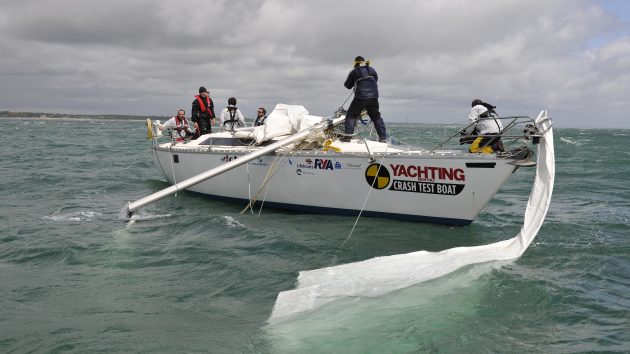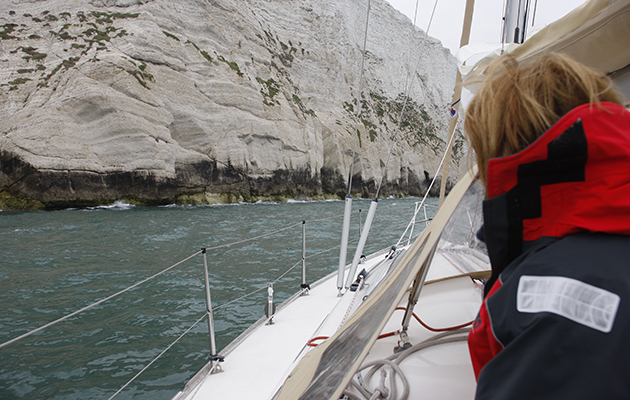What steps would you take if your yacht dismasted in a tidal race? James Stevens answers your questions of seamanship
Dismasted in a tidal race. What would you do?
James Stevens answers your questions of seamanship
Question:
Mike is on a coastal passage from Weymouth to Dartmouth.
His boat is Antares, a 10m cruising yacht with three crew. The wind is westerly Force 4.
Mike has opted to take the inshore passage around the main navigational hazard, Portland Bill.
The waters off Portland Bill are notoriously rough and dangerous with tide races of seven knots at springs, but today Mike reckons that the calmer water close inshore will be navigable if he arrives soon after the stream turns in his favour.
Antares has a deck stepped mast with a masthead rig, roller furling headsail, backstay, cap shrouds and lower shrouds.
The halyards and kicker are led back to jammers and winches in the cockpit.
Continues below…
The UK’s 11 fiercest tide races
Breaking waves and lurking rocks have earned some British tidal races a fearsome reputation. Dag Pike explains how to navigate…
How do I get out of a severe broach?
If your boat was about to broach what would you do? James Stevens answers your Questions of Seamanship
What does boat insurance cover?
What does boat insurance cover and why do boat owners need it? Mike Taylor reveals what lies behind this outlay
Could you help these mariners in distress?
James Stevens answers your questions of seamanship - this month, can you help another crew in distress?
On arriving at the Bill, the sea state is rougher and wind strength is stronger than Mike anticipated, sailing close to the wind is almost impossible.
Perhaps more worrying is that Mike has allowed the yacht to drift to seaward into the race.
There is a loud crack; for a moment the crew are slightly stunned and then realise almost the entire rig is over the side.
The problem appears to be that the lower shroud on the windward side has failed, the mast has snapped in the middle below the spreader, and the rig is held on by the remaining standing and running rigging.
The jagged broken end of the mast is already damaging the topside gel coat as the yacht pitches and rolls. What should Mike do now?
Answer:
The first priority is to prevent the jagged end of the mast from knocking a hole in the topsides. There are two ways of doing this.
Traditionally the rigging is cut away with powerful bolt croppers which few recreational yachts carry. A hacksaw would take too long.

James Stevens, author of the Yachtmaster Handbook, spent 10 years as the RYA’s Training Manager and Yachtmaster Chief Examiner
The other solution requires some kind of fendering and lashing the mast to the boat with the remaining rigging or warps.
If Mike is unable to do either of these quickly the yacht is in grave and imminent danger and a distress call with a mobile phone or the VHF radio is justified.
The engine is unusable with so many lines in the water. My view is that it is preferable to try and salvage the rig.
Cutting a large number of ropes and cables, including a forestay with a foil, can be a difficult job even with the right tools.
With some coordination and after the stream has taken the yacht out of the race, it should be possible to parbuckle the spars on to the toerail.
Also, if the rig is retained some of it may be reusable which is, of course, more environmentally friendly.
Once the rig is secured and a check has been made for any lines in the water, the engine can be started and Mike can aim for a port with a rigger.
Most owners realise how expensive and hazardous rig failure can be, and so do surveyors and insurance companies.
Enjoyed reading Dismasted in a tidal race. What would you do?
A subscription to Yachting Monthly magazine costs around 40% less than the cover price.
Print and digital editions are available through Magazines Direct – where you can also find the latest deals.
YM is packed with information to help you get the most from your time on the water.
-
-
- Take your seamanship to the next level with tips, advice and skills from our experts
- Impartial in-depth reviews of the latest yachts and equipment
- Cruising guides to help you reach those dream destinations
-
Follow us on Facebook, Twitter and Instagram.









